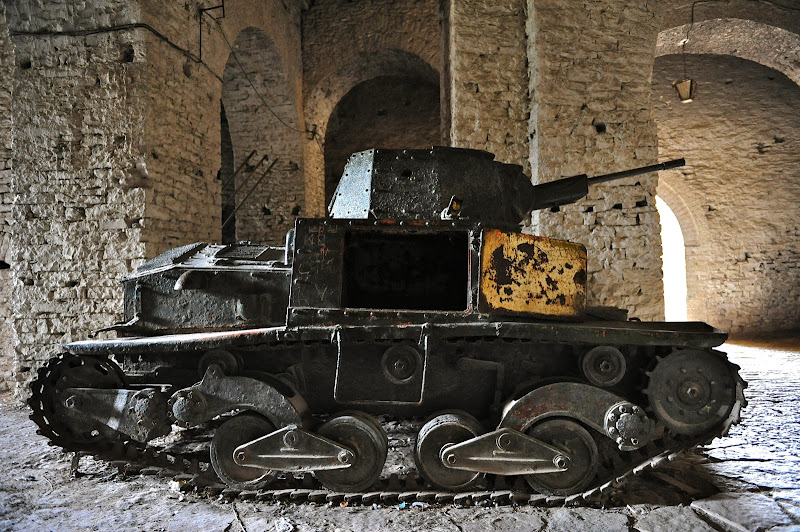Gjirokastër is a city that looks beautiful at any time of day, from any angle. A timeless sort of gorgeous, it is curvaceous with mountains and celebrated for its cascading mane of stone-roofed houses. Its unique beauty mark is its castle. Its birth mark. Sure, all by itself it's just a solid, harsh mass, but it makes everything around it more beguiling. You can see the castle from basically anywhere in Gjirokastër, which is particularly helpful when trying to navigate your way through the jumble of streets in the Old Town.
Someone way better at metaphors than I, Albanian-writer Ismail Kadare, grew up in Gjirokastër and described the city and its castle in his book Chronicle in Stone. The story takes place during World War II, when all the houses of the town were still topped with stone roofs and tumbled down the steep terrain with haphazard uniformity. Of the fortress, he writes:
Castles are lovely to look at (usually), but my favorite part is seeing what people have decided to do with the place. Will the museum inside tell the story of the fortress or will it depict castle life with recreated furnishings? Will there be a torture museum in the old prisons? Staff in uniform? Mannequins in guillotines? We knew that there was a Museum of Armaments inside, but found that it was closed. Still, we were met with guns-a-blazing, a collection of cannons from the First and Second World Wars. Our pamphlet called them "trophies," nabbed from the Italians (displayed along the right) and the Germans (along the left). The arched galleries and large guns served to make each other look bigger and more imposing.Someone way better at metaphors than I, Albanian-writer Ismail Kadare, grew up in Gjirokastër and described the city and its castle in his book Chronicle in Stone. The story takes place during World War II, when all the houses of the town were still topped with stone roofs and tumbled down the steep terrain with haphazard uniformity. Of the fortress, he writes:
"It had given birth to the city, and our houses resembled the citadel the way children look like their mothers."
Having just finished that book, I was extra excited to arrive in town and see Mama Castle with her silvery stone offspring huddled close by.
The castle was protected and turned into a cultural landmark in the years of Albanian Communism. So, obviously, the curatorial slant is going to be Albanian Supremacy, Power and Victory! (Or something along those lines). There isn't any propaganda involved anymore. In fact, the large populist leader sculpture, strong-jawed and draped in ammo, is pointed out as "communist propaganda of the time" of the museum's construction. The collection still speaks volumes, though. Here we have a Carro Armato Fiat tank of which there were only 243 made. This was captured from the Italians in Port Palermo. Operated by two people, it runs very slowly and can only be used for short distances, because it is run on coal. How crazy, a coal-powered Fiat military tank from the 40s.
If that tank is a head in a hunter's lodge, this plane is the bear skin rug. The aforementioned brochure lists this as "American Spy Plane," but the posted orientation map adds a question mark. "American Spy Plane?" Either by force or at the decision of the pilot, this plane landed at Tirana's airport in 1957 and may or may not have been carrying a spy from the USA. The Communist government's anti-western sentiment was, probably, mixed with fear and this plane was displayed as a warning to any other enemies. (Though, this prize catch really may have been more like roadkill. Some people say that an impending engine failure may have forced the landing).
In 1968, to celebrate Enver Hoxha's birthday, the first National Folk Festival took place on the grassy field atop the castle. From below, you can see this spherical pink stage ornament within the citadel's walls. We thought it was some sort of jungle gym. Every five years, this mainstage hosts the competition. Folk singers, dancers and musicians come from all corners of the country and perform for hundreds of spectators. It must be quite the venue. There are the guns, tank and plane - and then this stage, which is just as much of, if not a truer, expression of national pride.

Amazingly, even after Gjirokastër became a Museum Town and the castle had begun to be used for cultural events, the prisons remained in use. These predictably dank places with special punishment chambers had been expanded and widely used by King Zog, used "with zeal" by the occupying Nazis and then employed right up until 1971 by Hoxha's communists. Maybe in a decade or so, there will be information in the pamphlet about that third stage of the prison's life.
You have read this article Albania /
Castles /
Museums
with the title The Silver City's Castle. You can bookmark this page URL http://africathoughts.blogspot.com/2012/04/the-silver-city-castle.html. Thanks!
















No comment for "The Silver City's Castle"
Post a Comment